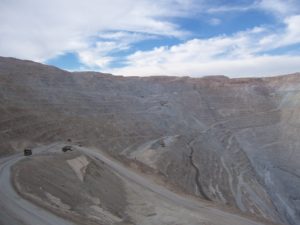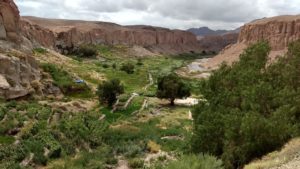The cost of water regulation in northern Chile
By Silke Schmidt
Water has many inherent values. It’s an important part of the natural environment; it’s a cultural asset for many indigenous communities; and it supports economic activities that provide jobs and steady incomes.
 Governments often introduce regulations to balance these competing values, with varying success. One such regulatory scheme, implemented in northern Chile, limited the use of water in the mining sector to protect the natural water system and the indigenous communities that rely on it. Understanding the economic and environmental costs of this policy was the subject of a recent study by CEnREP affiliate Eric Edwards and colleagues.
Governments often introduce regulations to balance these competing values, with varying success. One such regulatory scheme, implemented in northern Chile, limited the use of water in the mining sector to protect the natural water system and the indigenous communities that rely on it. Understanding the economic and environmental costs of this policy was the subject of a recent study by CEnREP affiliate Eric Edwards and colleagues.
“The goal of our study was to determine the cost of water trading restrictions in a market where water rights were previously traded without constraints,” says Edwards, an assistant professor in the Department of Agricultural and Resource Economics at NC State. “Since some of the policy’s costs were less obvious than others, we developed methods for making them more explicit.”
With American and Chilean collaborators, Edwards studied water use in in the Antofogasta region of northern Chile. It’s part of the Atacama Desert, often recognized as the driest on earth. Yet it also produces 17% of the world’s copper supply—and it takes a substantial amount of water to extract that copper.
Copper consistently accounts for over 50% of Chile’s exports, with the copper industry contributing over 10% of Chile’s total GDP and about half of regional GDP. The mining sector employs 23% of the indigenous and 18% of the non-indigenous population in the region.

Chile’s water code became effective in 1981 and, according to Edwards, resulted in some of the world’s strongest water property rights. Different from laws in many countries, Chilean law made water rights freely tradable and separate from land transactions. The market’s main buyers and sellers are farmers and mining companies; additional entities include agricultural organizations and the government.
In the late 1990s, concerns began to build about selling water rights to mining companies in perpetuity. The region’s main river had decreased by two-thirds from 1961 to 1990. Newly formed advocacy organizations were fighting more vocally for the protection of wetland ecosystems and of water access for indigenous farming communities. Rising copper prices on the world market in the 2000s spurred the interest of multinational firms to build additional mines in the region.
In 2003, Chile’s regulatory agency for water rights, the Dirección General de Aguas (DGA), began to respond to these concerns. Mining firms could still purchase water rights on paper, but the DGA rejected a growing number of applications to use that water for mining. In response, many firms began to pump seawater up to an elevation of 3,000 meters (9,800 feet) above sea level over distances of up to 150 km (93 miles). Most companies also built desalination facilities, further increasing costs.

To estimate the financial impact of the new DGA policy, Edwards and colleagues analyzed a dataset of 534 water right transfers (1995-2014). Using water market prices and the expense of pumping and desalination, they estimated the cost of potential market transactions that were lost due to regulation. The result was US$52 million per year. The policy’s main benefit is conserving the region’s ecological and agricultural water. An estimated 86% of the remaining supply would be transferred to mining without regulation.
However, Edwards notes that the annual cost estimate ignores other consequences. For example, the energy for pumping and desalination generates more than 720,000 metric tons of carbon dioxide emissions annually. With a social cost of carbon of $43 per metric ton, the policy’s environmental cost exceeds $30 million per year. On the other hand, if mining companies no longer pay for water pumping, perhaps due to falling copper prices on the world market, many jobs in the region may be lost.
For Edwards, the study illustrates that when water is extremely scarce, regulation to conserve it can be costly.
“Chile is an extreme example with some of the world’s most precious water,” he concludes. “But the lessons from our analysis apply to many other countries, including the U.S., where people face similar decisions about preserving and protecting access to finite resources.”
